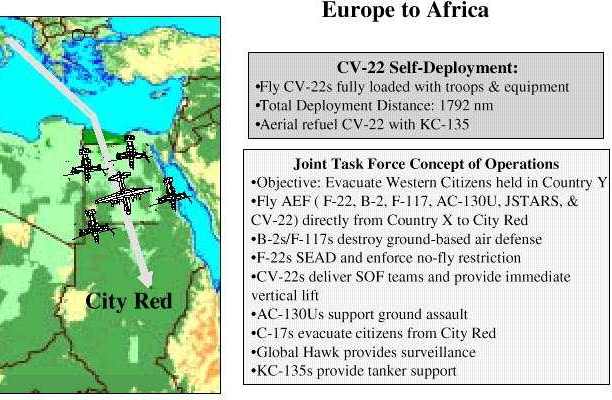Several new systems and capabilities are entering the Joint Force structure that will enable force commanders to operate in ways that were not previously possible. The B-2 and F-117 loaded with Joint Direct Attack Munitions and other high precision ordinance offer the capability to quickly destroy air defenses and other strategic targets.
CV-22s can launch from extended ranges, aerial refuel with KC-135s, fly 300 feet above terrain at high speed inside hostile air space, then simultaneously deliver ground assault teams to multiple objectives.
After deploying the assault teams, the CV-22s provide an immediate vertical lift
capability that can be used for multiple support missions, including: ground force redeployment; non-combatant evacuation; medical evacuation; combat search and rescue; surveillance/reconnaissance; force protection support and various weapons of mass destruction contingency roles.
The AC-130U can deliver a high-volume of ordinance with high precision and minimal collateral damage that can be used to eliminate point defenses, suppress opposition and destroy Command, Control and Communications (C 3 I) centers.
Finally, the C-17 can land and take off from short, unpaved runways using a flight profile that minimizes its vulnerability to air defenses.
The above scenario describes a fictional, contested non-combatant evacuation operation (NEO) that shows how these new capabilities might be integrated into a highly effective, coordinated air and ground assault operation.
The CV-22 performed several essential roles in this simulated operation. CV-22s
took off from an air station in "Country X" fully loaded with troops and equipment and flew non-stop to "City Red." They aerial refueled with KC-135s twice before entering "Country Y." Inside "Country Y," they flew 300 feet above terrain at high speed and arrived simultaneously at "City Red" with the other Air Expeditionary Force (AEF) units. Then they simultaneously delivered
the ground assault teams directly to multiple objectives inside "City Red." After the objectives were secured, they evacuated the non-combatants to KIA and performed other essential vertical lift operations, including: troop lift and aeromedical evacuation; standby Combat, Search and Rescue and force protection support.
The operation highlighted the synergy between the CV-22 and the other AEF forces, particularly the AC-130U. The AC-130's high-volume, high-precision ordinance capability rapidly destroyed external defenses and command centers. This enabled the CV-22 to deliver a lightly armed ground force directly to the objective without the need for additional heavy force support.

Demonstration illustrates MV-22 potential to U.S. Marine Corps
On Oct. 4, 2000 university students organized a mass demonstration on the U.S. Embassy in Damascus, Syria in protest of killings in
Palestine. Muhammad Al-Abdallah, a reporter from Al-Jazeera TV said, "The strict security measures that surrounded
the embassy in Damascus did not stop the angry demonstrators from throwing a hail of stones at it...which destroyed the glass
of the embassy's doors and windows...Some demonstrators climbed the embassy roof and brought down the U.S. flag."
Though not required during this demonstration, it raises questions about how best to evacuate embassy personnel
there, if necessary.
The Marine Corps believes the MV-22 tiltrotor aircraft is just the ticket for "this or any kind of non-combatant
evacuation in any part of the world," a service spokesman tells The DAILY. The requirements for the MV-22 were developed after
the failed attempt to rescue hostages in Iran 20 years ago during Desert One, he explains.
"The MV-22 gives us the ability to travel inland from the sea and provides the increased range, speed and flexibility
necessary for such a type of operations."
See Also :
